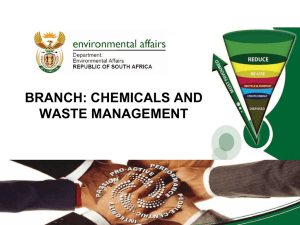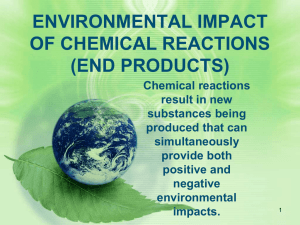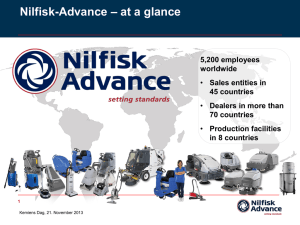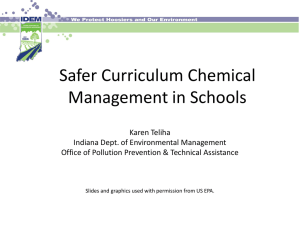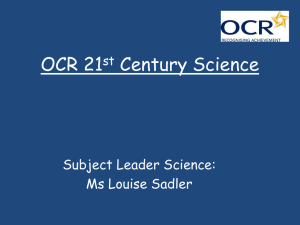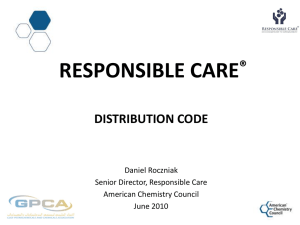Marion Healy - Helsinki Chemicals Forum
advertisement
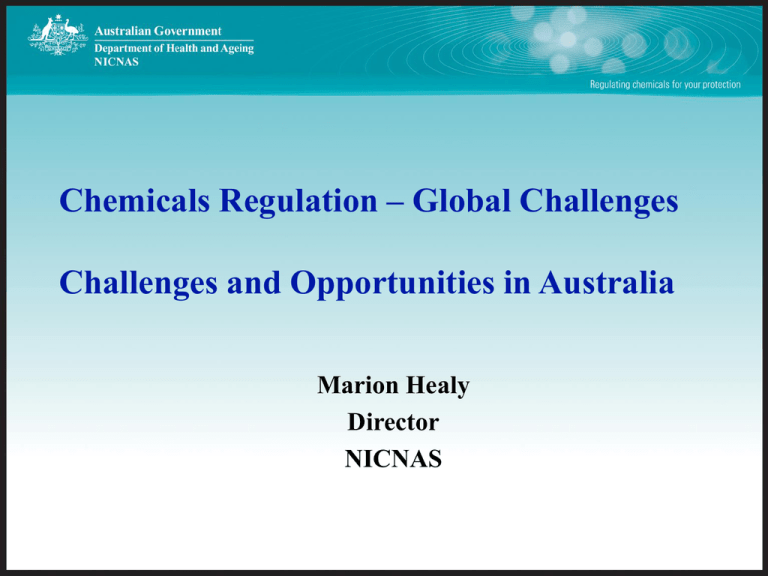
Chemicals Regulation – Global Challenges Challenges and Opportunities in Australia Marion Healy Director NICNAS Challenges and Opportunities Existing chemicals - identifying and managing chemicals of concern New chemicals - efficiency and effectiveness of regulatory framework New Technologies – safe and sustainable use of nanomaterials 1. Existing Chemicals: Managing chemicals of concern Major review of EC Program finalised in 2006 Major complex assessments, resource intensive Small number of chemicals assessed, most chemicals on the inventory not assessed Other countries/regions moving towards screening chemicals on inventories Aim of new initiative Identify chemicals of concern – systematic, comprehensive, flexible and transparent require a paradigm shift Reviewed other approaches for applicability to Australia Screening of inventory listed chemicals in use Prioritise chemicals for further evaluation 1. Existing Chemicals: Implications of Other Schemes Issue Implications Data to underpin prioritisation & assessment Generated for national, regional & international schemes. How to reduce duplication of effort? Which chemicals are in use Appears to differ across regions and time. Little Australian data available Similarity of listed chemicals to other inventories Which chemicals are hazardous Significant overlap (up to 60%), BUT > 5,000 Australia only chemicals. Similar distributions of different types of chemicals Many chemicals – no public information. Predictive modelling offers options. Sharing information Balancing confidentiality, reduced duplication 2. New Chemicals: More Efficient Regulatory Frameworks Low regulatory concern chemicals Fast tracked introduction of low risk and/or previously assessed chemicals safer chemicals Significantly expanded options to introduce safer chemicals Evaluation indicates successful strategy, although limited uptake. Impact on safety flexibility, innovation and cost. Multi and bi lateral cooperative activities Achieve efficiencies in assessing/ managing chemicals; enhance ability to protect human health and the environment Bilateral – 3 agreements in place Range from information exchange to work sharing Multilateral – Formal work share activities of OECD and WHO; Treaty commitments 2. New Chemicals: Impact of Initiatives Issue Implications Balance of Balance facilitating innovation while requirements for new protecting human health and the environment? and existing chems Should hurdles for new and existing chemicals be the same? Sharing assessment Multilateral organisations promote approaches – harmonisation but also innovative approaches. methodologies, tools Opportunities to exploit? Sharing assessments Bilateral approaches effective; confidence - bilateral building and bench marking. Sharing assessments Progress is slower – reflects differences in - multilateral national legislative and expectations. How to overcome? 3. Regulatory Principles for New Technologies REVIEW EXISTING FRAMEWORK If appropriate, utilise existing framework with suitable procedural or regulatory changes. Consider if a new system for regulation is required. Conduct and review with transparency and inclusive processes. MAKE USE OF BEST SCIENTIFIC EVIDENCE Ability to review decisions as new evidence becomes available. TAKE MEASURES TO PROTECT HEALTH & ENVIRONMENT When scientific evidence is insufficient to support safety, adopt measure to protect human health, safety and the environment Risk should be no greater than risk from conventional chemicals Address risk pre market Support industry innovation with appropriate regulatory oversight. 3. New Technologies: Nanomaterials Issue Implications Safety of nanomaterials Is there sufficient information to determine safety? Appears to be significant uncertainty. Regulatory framework Are modifications to our current framework necessary? Probably. Community concerns Will these concerns derail use of nanomaterials? Can regulation allay concerns and promote innovation? An objective! Are there opportunities for international harmonisation of assessments and regulatory approaches? Yes. International harmonisation Challenges and Opportunities Initiatives underway to: identify and manage existing chemicals of concern improve efficiency and effectiveness of new chemical processes facilitate the safe and sustainable use of nanomaterials Support robust assessments that are risk based and ‘fit for purpose’ Opportunities for greater levels of cooperation both bi- and multi- laterally - information generated/collated, assessment and regulatory approaches, work share arrangements Made significant progress and optimistic about future progress

